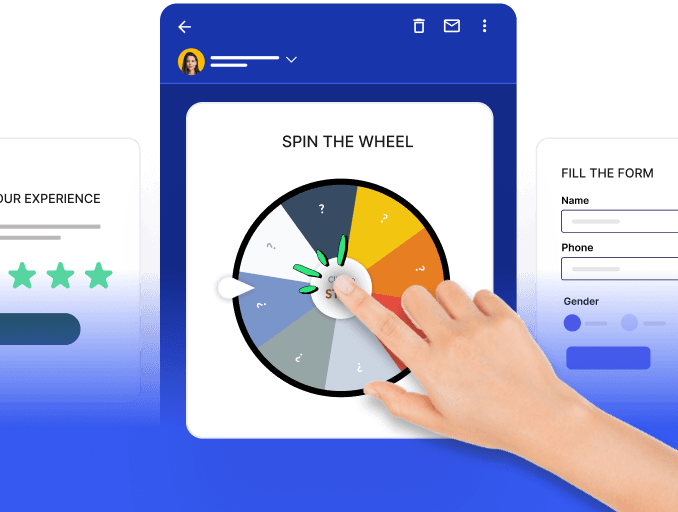Whether you're new to email marketing or have been in the field for quite some time now, you must be aware of the common terminologies and concepts to be successful. While the email marketing sector is a rapidly evolving one, and there’s something new to learn about every day, there are some terms that you can’t miss out on. To help you, we have compiled a comprehensive email marketing glossary of 58 key email marketing terms you need to know. So let’s get started.
Table of contents
58 email marketing terms you need to know
- A/B testing
- Acceptance rate
- AMP emails
- Autoresponder
- Behavioral email
- Blacklist
- Body copy
- Bounce rate
- Call-to-action (CTA)
- CAN-SPAM act
- Click-through rate (CTR)
- Conversion rate
- DKIM
- DMARC
- Demographics
- Double opt-in
- Drip campaign
- Drip Marketing
- Dynamic content
- Email analytics
- Email automation
- Email client
- Email campaign
- Email deliverability
- Email list
- Email segmentation
- Email service provider (ESP)
- Email signature
- Email template
- Engagement
- Fallback email
- GDPR
- Hard bounce
- HTML
- Interactive emails
- IP warming
- Lead nurturing
- Lead magnet
- List hygiene
- List Segmentation
- Open rate
- Opt-in
- Personalization
- Phishing
- Plain text emails
- Responsive design
- Return on investment (ROI)
- SMTP
- SPF
- Soft bounce
- Spam
- Spam filter
- Subscriber
- Subject line
- Single opt-in
- Transactional email
- Trigger email
- Unsubscribe rate
- Whitelist
- WYSIWYG editor
58 email marketing terms you need to know
Here’s the curated list of email marketing terms you must know if you aspire to be an email marketer or are already an email marketer.
A/B testing
A/B testing, or a/b split test, is a way to improve your email marketing campaigns. It involves comparing two different versions of an email and seeing which one works best for your target audience.
Acceptance rate
An acceptance rate is the percentage of email messages that are accepted by the mail server.
AMP emails
AMP (Accelerated Mobile Pages) emails are a new technology that allows you to include interactive and dynamic content within email messages.
Autoresponder
An autoresponder is an automated message or series of messages that are sent in response to a trigger or action to a particular address. Autoresponders are often used to send out-of-office emails and confirmations.
Behavioral email
Behavioral email marketing is a powerful tool that allows businesses to send targeted emails based on the recipient's actions and behavior. By analyzing user interactions with the business on various platforms, behavioral email campaigns can be tailored to increase customer engagement and drive sales.
Blacklist
A blacklist refers to a list of email addresses, IP addresses, or domains identified as sources of spam or malicious activity and is blocked from sending emails.
Body copy
Body copy refers to the main content or text within an email. It is an essential component of the email.
Bounce rate
Bounce rate refers to the percentage of emails that are not delivered to the recipient's inboxes. Bounces can be classified as either hard bounces or soft bounces.
Call-to-action (CTA)
The call-to-action (CTA) is a crucial element of email content that prompts subscribers to take a specific action. Focusing on a single CTA can help you optimize conversions, from your email template to your landing page.
CAN-SPAM act
The CAN-SPAM Act sets rules for commercial emails, gives recipients rights to stop receiving emails, and outlines penalties for violations of these regulations.
Click-through rate (CTR)
The click-through rate (CTR) measures the percentage of people who clicked on a link in your email. It is calculated by dividing the number of unique clicks by the total number of people who opened your email.
Conversion rate
The conversion rate is the percentage of readers who take the desired action after receiving your email. This desired action can be making a purchase, signing up for a service, downloading a resource and so on.
DKIM
DKIM (Domain Keys Identified Mail) is an authentication method that verifies the authenticity of email messages by adding a digital signature to the header of the outgoing emails.
DMARC
DMARC (Domain-based Message Authentication, Reporting, and Conformance) is an email validation protocol that builds upon SPF and DKIM to prevent email phishing and spoofing.
Demographics
Demographics in email marketing terms refer to customer data based on common characteristics like age, gender, location, and interests.
Double opt-in
Double opt-in is a method where subscribers are needed to confirm their email subscription by responding to a confirmation email in addition to opting in on a website.
Drip campaign
A drip campaign is a series of pre-written emails sent to a specific group of subscribers over a set period of time.
Drip Marketing
Drip marketing is an essential strategy in email marketing where a series of pre-written emails are sent to recipients based on their behavior and interactions with previous emails. This automated approach allows businesses to nurture leads, build relationships, and guide customers through the sales funnel over a period of time.
Dynamic content
Dynamic content refers to email content that changes based on the recipient's behavior, preferences, or demographics and updates in real time.
Email analytics
Email analytics is the process of tracking, analyzing and interpreting data related to your email marketing strategy campaigns.
Email automation
Email automation is the process of automatically sending emails to subscribers based on predefined events or triggers in email Marketing Automation.
Email client
Email client is a software used by recipients to access and manage their email. Common examples include Outlook is one of the most popular email clients out there others are Gmail, and Apple Mail so on.
Email campaign
An email campaign is a series of emails sent to a group of recipients that are intended to help you reach a certain goal.
Email deliverability
Email deliverability is the ability of your email to reach the recipients' inboxes.
Email list
An email list is a curated list of email addresses to whom businesses send marketing emails and updates.
Email segmentation
In email marketing terms, Email segmentation is the practice of dividing email subscribers or your email list into different segments like smaller groups based on criteria like demographics, preferences, activity, or purchase history to send more targeted emails.
Email service provider (ESP)
In email marketing terms, email service provider (ESP) is a company or platform that offers email services to its customers and allows them to create, send and manage marketing emails and email campaigns.
Email signature
This is an essential component of an email marketing terms, typically located at the end of an email and contains important information like the sender’s name, job title, company and contact information.
Email template
An email template is a pre-designed layout or email that can be edited and used for creating consistent looking emails.
Engagement
Engagement refers to the interaction, participation, and response that your emails receive from your recipients. It can mean opening your emails, clicking on links, downloading a resource, etc.
Fallback email
A fallback email is a backup or alternative version of an email message that is displayed when the original email content cannot be displayed or rendered properly.
GDPR
The General Data Protection Regulation (GDPR) is a set of laws in the European Union (EU) that regulates how data is collected and processed. The GDPR applies because it involves processing personal data for communication purposes.
Hard bounce
A hard bounce is when an email is not delivered to the recipient and is returned to the sender because of reasons like the email address being invalid, the sender being blocked by the recipient and so on.
HTML
HTML (Hypertext Markup Language) is the coding language used to create and structure web pages and their content.
Interactive emails
Interactive emails are emails that include interactive elements within the email and allow recipients to engage with the content of the email.
IP warming
IP warming is a process where marketers gradually increase the volume of emails sent through a new IP address to establish a positive sending reputation.
Lead nurturing
Lead nurturing is the process of building relationships with potential customers at different stages of the sales funnel by sending them targeted and relevant emails, leading them to a purchase.
Lead magnet
A lead magnet is an incentive or offer provided by a business in exchange for a customer’s information, like their email address, name, pin code and additional information.
List hygiene
Email list hygiene refers to the process of keeping your email contact list clean and up-to-date by validating the email addresses and removing inactive or unwanted subscribers on a regular basis to improve deliverability.
List Segmentation
List segmentation is a vital strategy employed by email marketers to split their contact lists into separate groups or segments. By organizing your email list according to factors such as demographics, behavior, or preferences, you can send precisely tailored emails with pertinent content to each segment.
Open rate
Open rate is the percentage of recipients who opened of the total number of emails. It is measured by tracking the number of emails by the total number of delivered emails.
Opt-in
Opt-in refers to the practice where recipients willingly subscribe or agree to receive emails from a sender. This is them giving consent.
Personalization
Personalization is a marketing technique in which senders use subscriber data to customize their emails and send unique emails to the different subscribers in the list.
Phishing
Phishing involves fraudulent attempts to obtain sensitive information like passwords or credit card numbers by impersonating a trustworthy entity in an email.
Plain text emails
Plain text emails are those emails that contain only text, without any images, links, graphics, HTML code, or styling.
Responsive design
Responsive design customizes the size and layout of the email to fit different screens while maintaining its style and usability. It ensures that your email looks great and functions well on any device or email client.
Return on investment (ROI)
Return on investment (ROI) is a key performance metric that measures the profitability or success of an email marketing campaign. ROI is calculated by dividing the net revenue generated from the campaign by the total cost of the campaign and expressing it as a percentage.
SMTP
SMTP (Simple Mail Transfer Protocol) is a communication protocol and is used for sending email messages between servers.
SPF
SPF (Sender Policy Framework) is an email authentication method that helps prevent email spoofing.
Soft bounce
A soft bounce is when an email is rejected due to a temporary difficulty, such as a full inbox or a server error.
Spam
Spam is an uninvited commercial email that is sent to recipients without their consent. Spam emails are frequently sent in enormous amounts and may contain false, misleading, or deceptive content.
Spam filter
Spam filter is a system that automatically identifies and filters spam or unwanted messages and keeps them out of receivers' inboxes.
Subscriber
A subscriber refers to an individual who has provided their email address or contact information and consented to receive communications from a business or organization. Contacts who opt in to receive promotional emails become subscribers. The same exact email sent to a large number of recipients or your entire subscriber list.
Subject line
The subject line is the headline of an email that appears in the recipient's inbox. It is one of the first things subscribers see and plays a crucial role in determining whether they open the email or not.
Single opt-in
Single opt-in is a method where users only need to provide their email address to subscribe to a mailing list without having to re-confirm their subscription like in case of a double opt-in. This means they can be signed up for a list by someone else, and as such is not a recommended way to build a healthy email marketing list .
Transactional email
These are messages sent to individual recipients and are triggered by a transaction or specific actions or interactions on a website or application.
Trigger email
This is an automated message sent in response to a specific action taken by a subscriber.
Unsubscribe rate
The unsubscribe rate is the percentage of subscribers who opt out or unsubscribe from receiving further emails from a sender. It’s technically a request to leave your email list.
Whitelist
A whitelist is a list of specific email addresses or domains that are deemed safe and are allowed to bypass spam filters.
WYSIWYG editor
A WYSIWYG (What You See Is What You Get) editor allows users to create emails visually without needing to know HTML or other coding languages.
Conclusion
Mastering key email marketing terms is very important to achieve success in email marketing. Understanding these terminologies, which range from basic ideas to technical aspects, improves knowledge and helps marketers design effective campaigns while staying legally compliant.







